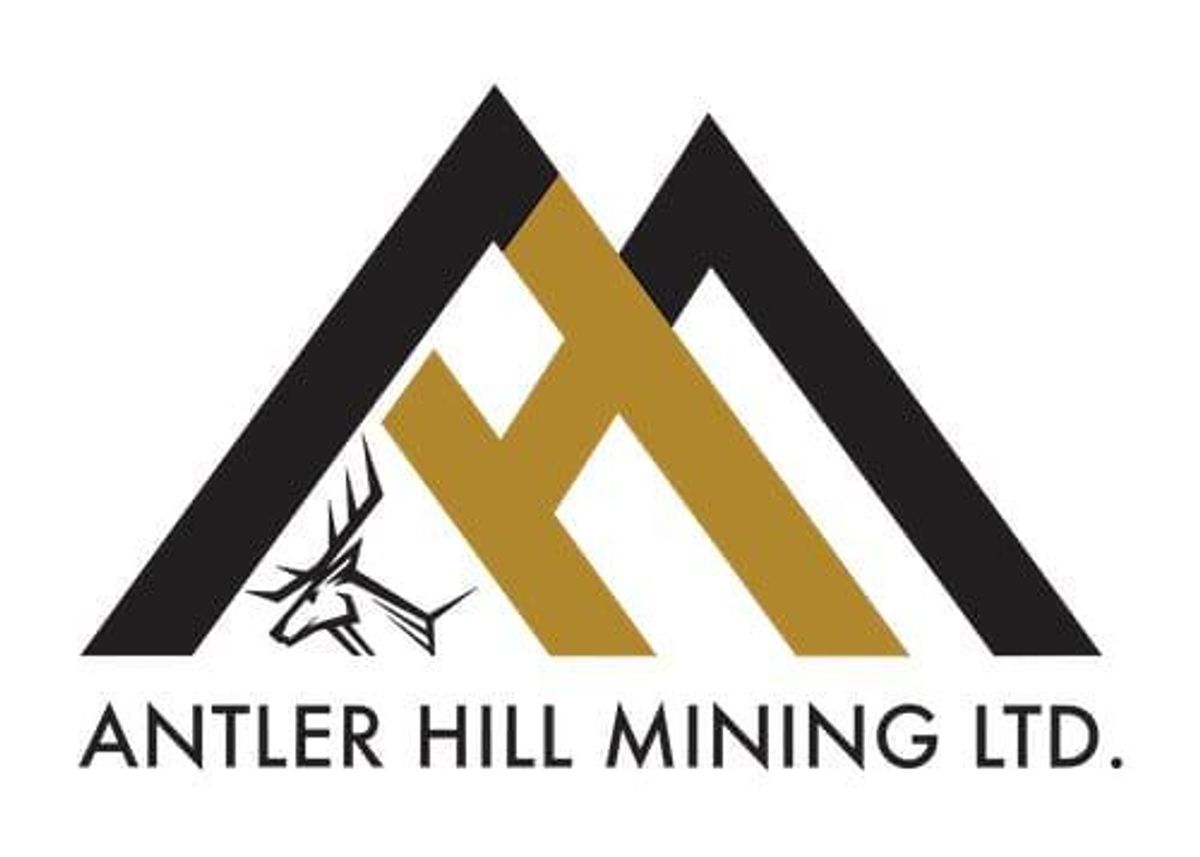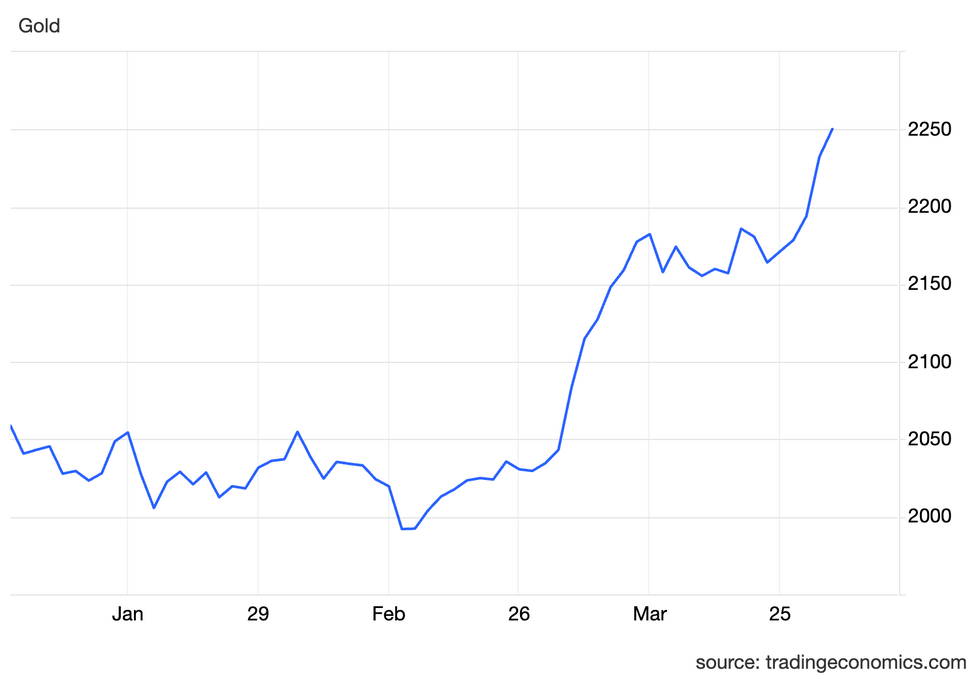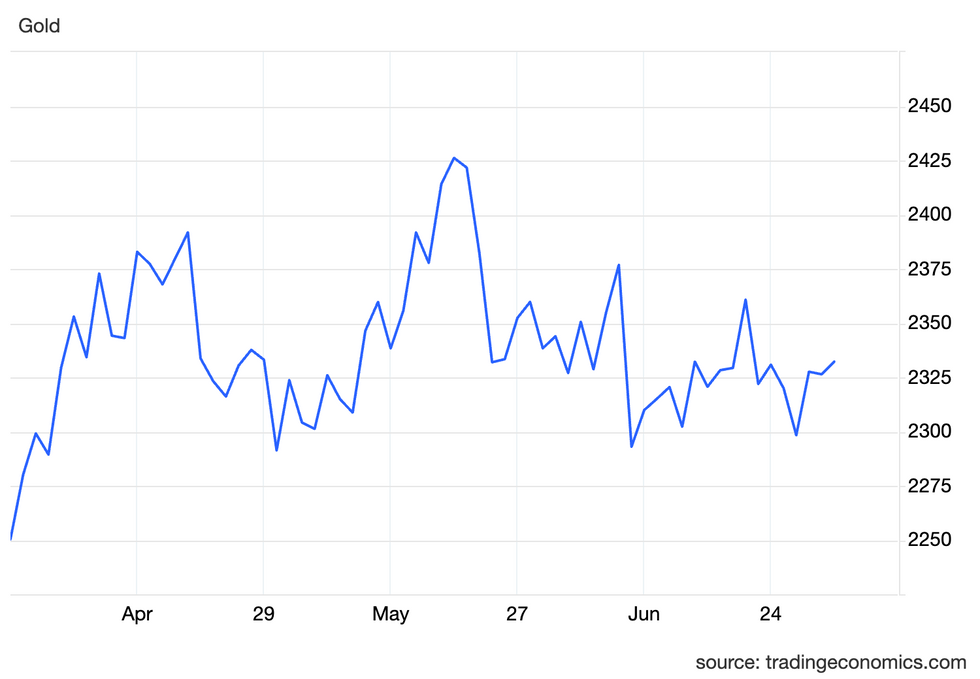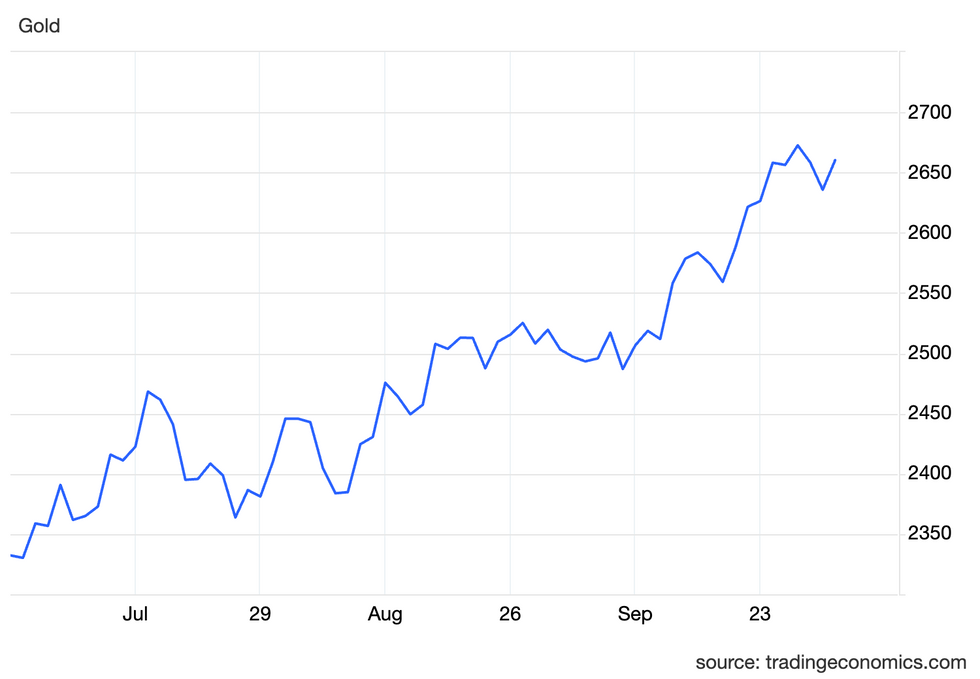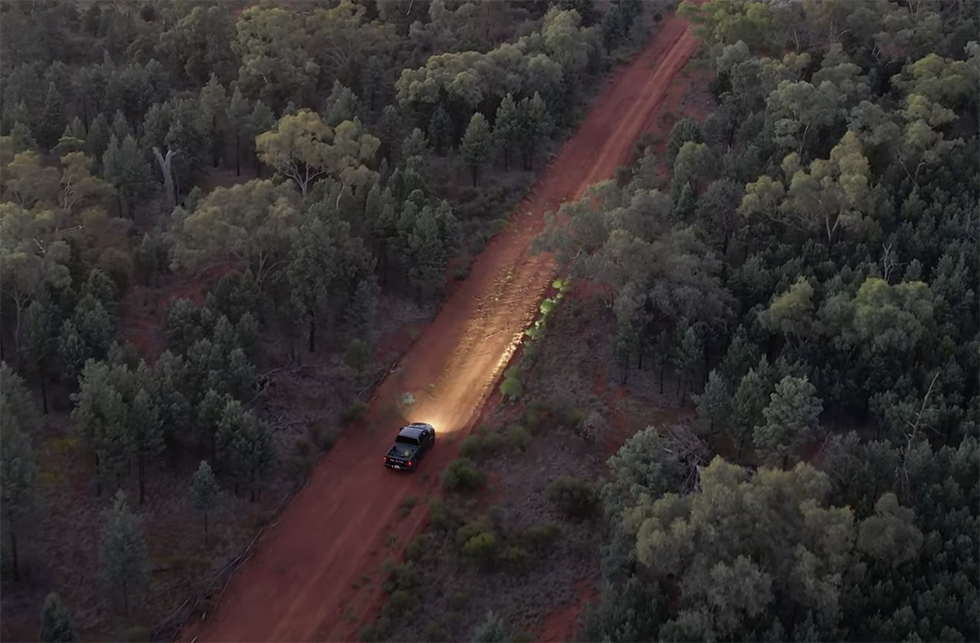All amounts expressed in US dollars
Barrick Gold Corporation (NYSE:GOLD)(TSX:ABX) ("Barrick" or the "Company") today reported preliminary full year and fourth quarter 2023 production results. On the back of higher Q4 production, preliminary gold production for the full year of 4.05 million ounces was consistent with our forecast as guided in our third quarter release. 1 Preliminary copper production of 420 million pounds for 2023 was within the guidance range of 420 to 470 million pounds.
The preliminary Q4 results show sales of 1.04 million ounces of gold and 117 million pounds of copper, as well as preliminary Q4 production of 1.05 million ounces of gold and 113 million pounds of copper. The average market price for gold in Q4 was $1,971 per ounce and the average market price for copper in Q4 was $3.70 per pound.
Preliminary Q4 gold production was an improvement on Q3 and was the highest quarter for the year with stronger performances from Cortez, Phoenix and Pueblo Viejo. This was partially offset by lower production at Loulo-Gounkoto, as planned, which still finished the year at the top end of the guidance range. Compared to Q3, Q4 gold cost of sales per ounce 2 is expected to be 6% to 8% higher, total cash costs per ounce 3 are expected to be 7% to 9% higher and all-in sustaining costs per ounce 3 are expected to be 8% to 10% higher than the prior quarter.
Preliminary Q4 copper production was in line with Q3, with consistent production across all three sites. Compared to Q3, Q4 copper cost of sales per pound 2 is expected to be 8% to 10% higher, C1 cash costs per pound 3 are expected to be 5% to 7% higher and all-in sustaining costs per pound 3 is expected to be 2% to 4% lower, principally on the back of lower capitalized waste stripping at Lumwana.
Barrick will provide additional discussion and analysis regarding its full year and Q4 2023 production and sales when the Company reports its quarterly and full year results before North American markets open on February 14, 2024.
The following table includes preliminary gold and copper production and sales results from Barrick's operations:
| Three months ended December 31, 2023 | Twelve months ended December 31, 2023 | |||
| Production | Sales | Production | Sales | |
| Gold (attributable ounces (000)) | ||||
| Carlin (61.5%) | 224 | 220 | 868 | 865 |
| Cortez (61.5%) | 162 | 164 | 549 | 548 |
| Turquoise Ridge (61.5%) | 84 | 86 | 316 | 318 |
| Phoenix (61.5%) | 41 | 39 | 123 | 120 |
| Long Canyon (61.5%) | 2 | 2 | 9 | 9 |
| Nevada Gold Mines (61.5%) | 513 | 511 | 1,865 | 1,860 |
| Loulo-Gounkoto (80%) | 127 | 127 | 547 | 546 |
| Kibali (45%) | 93 | 92 | 343 | 343 |
| Pueblo Viejo (60%) | 90 | 89 | 335 | 335 |
| North Mara (84%) | 59 | 61 | 253 | 254 |
| Veladero (50%) | 55 | 46 | 207 | 182 |
| Tongon (89.7%) | 42 | 42 | 183 | 185 |
| Bulyanhulu (84%) | 41 | 41 | 180 | 180 |
| Hemlo | 34 | 33 | 141 | 139 |
| Total Gold | 1,054 | 1,042 | 4,054 | 4,024 |
| Copper (attributable pounds (millions)) | ||||
| Lumwana | 73 | 70 | 260 | 249 |
| Zaldívar (50%) | 23 | 26 | 89 | 92 |
| Jabal Sayid (50%) | 17 | 21 | 71 | 67 |
| Total Copper | 113 | 117 | 420 | 408 |
Fourth Quarter and Full Year 2023 Results
Barrick will release its Q4 and full year 2023 results before market open on February 14, 2024. President and CEO Mark Bristow will host a live presentation of the results that day at 11:00 EST with an interactive webinar linked to a conference call. Participants will be able to ask questions.
Go to the webinar
US and Canada (toll-free) 1 800 319 4610
UK (toll-free) 0808 101 2791
International (toll) +1 416 915 3239
The Q4 and full year 2023 presentation materials will be available on Barrick's website at www.barrick.com .
The webinar will remain on the website for later viewing, and the conference call will be available for replay by telephone at 1 855 669 9658 (US and Canada toll-free) and +1 604 674 8052 (international toll), access code 0603.
Enquiries:
Kathy du Plessis
Investor and Media Relations
+44 20 7557 7738
barrick@dpapr.com
Website: www.barrick.com
Technical Information
The scientific and technical information contained in this news release has been reviewed and approved by: Craig Fiddes, SME-RM, Manager - Resource Modeling, Nevada Gold Mines; Chad Yuhasz, P.Geo, Mineral Resource Manager, Latin America and Asia Pacific; and Richard Peattie, MPhil, FAusIMM, Mineral Resources Manager: Africa & Middle East — each a "Qualified Person" as defined in National Instrument 43-101 - Standards of Disclosure for Mineral Projects .
Endnote 1
Porgera was placed on temporary care and maintenance from April 25, 2020 to December 22, 2023 and was not included in our full year 2023 guidance. On December 22, 2023, following the granting of the new Special Mining Lease to New Porgera Limited, the Porgera Project Commencement Agreement was formally completed. The Company expects to include Porgera in our 2024 guidance when it reports its full year and fourth quarter results on February 14, 2024.
Endnote 2
Gold cost of sales per ounce is calculated as cost of sales across our gold operations (excluding sites in care and maintenance) divided by ounces sold (both on an attributable basis based on Barrick's ownership share). Copper cost of sales per pound is calculated as cost of sales across our copper operations divided by pounds sold (both on an attributable basis based on Barrick's ownership share).
References to attributable basis means our 100% share of Hemlo and Lumwana, our 89.7% share of Tongon, our 84% share of North Mara and Bulyanhulu, our 80% share of Loulo-Gounkoto, our 61.5% share of Nevada Gold Mines, our 60% share of Pueblo Viejo, our 50% share of Veladero, Zaldívar and Jabal Sayid and our 45% share of Kibali.
Endnote 3
Total cash costs per ounce and all-in sustaining costs per ounce are non-GAAP financial measures which are calculated based on the definition published by the World Gold Council ("WGC") (a market development organization for the gold industry comprised of and funded by gold mining companies from around the world, including Barrick). The WGC is not a regulatory organization. Management uses these measures to monitor the performance of our gold mining operations and its ability to generate positive cash flow, both on an individual site basis and an overall company basis.
Total cash costs start with our cost of sales related to gold production and removes depreciation, the non-controlling interest of cost of sales and includes by-product credits. All-in sustaining costs start with total cash costs and include sustaining capital expenditures, sustaining leases, general and administrative costs, minesite exploration and evaluation costs and reclamation cost accretion and amortization. These additional costs reflect the expenditures made to maintain current production levels.
We believe that our use of total cash costs and all-in sustaining costs will assist analysts, investors and other stakeholders of Barrick in understanding the costs associated with producing gold, understanding the economics of gold mining, assessing our operating performance and also our ability to generate free cash flow from current operations and to generate free cash flow on an overall company basis. Due to the capital-intensive nature of the industry and the long useful lives over which these items are depreciated, there can be a significant timing difference between net earnings calculated in accordance with IFRS and the amount of free cash flow that is being generated by a mine and therefore we believe these measures are useful non-GAAP operating metrics and supplement our IFRS disclosures. These measures are not representative of all of our cash expenditures as they do not include income tax payments, interest costs or dividend payments. These measures do not include depreciation or amortization.
Total cash costs per ounce and all-in sustaining costs per ounce are intended to provide additional information only and do not have standardized definitions under IFRS and should not be considered in isolation or as a substitute for measures of performance prepared in accordance with IFRS. These measures are not equivalent to net income or cash flow from operations as determined under IFRS. Although the WGC has published a standardized definition, other companies may calculate these measures differently.
C1 cash costs per pound and all-in sustaining costs per pound are non-GAAP financial measures related to our copper mine operations. We believe that C1 cash costs per pound enables investors to better understand the performance of our copper operations in comparison to other copper producers who present results on a similar basis. C1 cash costs per pound excludes royalties and production taxes and non-routine charges as they are not direct production costs. All-in sustaining costs per pound is similar to the gold all-in sustaining costs metric and management uses this to better evaluate the costs of copper production. We believe this measure enables investors to better understand the operating performance of our copper mines as this measure reflects all of the sustaining expenditures incurred in order to produce copper. All-in sustaining costs per pound includes C1 cash costs, sustaining capital expenditures, sustaining leases, general and administrative costs, minesite exploration and evaluation costs, royalties and production taxes, reclamation cost accretion and amortization and write-downs taken on inventory to net realizable value.
Barrick will provide a full reconciliation of these non-GAAP financial measures when the Company reports its full year and fourth quarter results on February 14, 2024.
Cautionary Statements Regarding Preliminary Fourth Quarter and Full Year Production, Sales and Costs for 2023, and Forward-Looking Information
Barrick cautions that, whether or not expressly stated, all full year and fourth quarter figures contained in this press release including, without limitation, production levels, sales and associated costs are preliminary, and reflect our expected full year and fourth quarter results as of the date of this press release. Actual reported full year and fourth quarter production levels, sales and associated costs are subject to management's final review, as well as review by the Company's independent accounting firm, and may vary significantly from those expectations because of a number of factors, including, without limitation, additional or revised information, and changes in accounting standards or policies, or in how those standards are applied. Barrick will provide additional discussion and analysis and other important information about its full year and fourth quarter production levels, sales and associated costs when it reports actual results on February 14, 2024. For a complete picture of the Company's financial performance, it will be necessary to review all of the information in the Company's full year and fourth quarter financial report and related MD&A. Accordingly, readers are cautioned not to rely solely on the information contained herein.
Finally, Barrick cautions that this press release contains forward-looking statements with respect to: (i) Barrick's production; and (ii) costs per ounce for gold and per pound for copper.
Forward-looking statements are necessarily based upon a number of estimates and assumptions including material estimates and assumptions related to the factors set forth below that, while considered reasonable by the Company as at the date of this press release in light of management's experience and perception of current conditions and expected developments, are inherently subject to significant business, economic, and competitive uncertainties and contingencies. Known or unknown factors could cause actual results to differ materially from those projected in the forward-looking statements, and undue reliance should not be placed on such statements and information.
Such factors include, but are not limited to: fluctuations in the spot and forward price of gold, copper, or certain other commodities (such as silver, diesel fuel, natural gas, and electricity); the speculative nature of mineral exploration and development; changes in mineral production performance, exploitation, and exploration successes; the timeline for the resumption of mining and processing operations and anticipated production from Porgera; risks associated with projects in the early stages of evaluation, and for which additional engineering and other analysis is required; disruption of supply routes which may cause delays in construction and mining activities; whether benefits expected from recent transactions are realized; quantities or grades of reserves will be diminished, and that resources may not be converted to reserves; increased costs, delays, suspensions and technical challenges associated with the construction of capital projects; operating or technical difficulties in connection with mining or development activities, including geotechnical challenges, tailings dam and storage facilities failures, and disruptions in the maintenance or provision of required infrastructure and information technology systems; risks that exploration data may be incomplete and considerable additional work may be required to complete further evaluation, including but not limited to drilling, engineering and socioeconomic studies and investment; failure to comply with environmental and health and safety laws and regulations; increased costs and physical risks, including extreme weather events and resource shortages, related to climate change; timing of, receipt of, or failure to comply with, necessary permits and approvals; non-renewal of key licenses by governmental authorities; uncertainty whether some or all of targeted investments and projects will meet the Company's capital allocation objectives and internal hurdle rate; the impact of inflation, including global inflationary pressures driven by supply chain disruptions and global energy cost increases following the invasion of Ukraine by Russia; the impact of global liquidity and credit availability on the timing of cash flows and the values of assets and liabilities based on projected future cash flows; fluctuations in the currency markets; changes in national and local government legislation, taxation, controls or regulations and/or changes in the administration of laws, policies and practices; expropriation or nationalization of property and political or economic developments in Canada, the United States, and other jurisdictions in which the Company or its affiliates do or may carry on business in the future; lack of certainty with respect to foreign legal systems, corruption and other factors that are inconsistent with the rule of law; damage to the Company's reputation due to the actual or perceived occurrence of any number of events, including negative publicity with respect to the Company's handling of environmental matters or dealings with community groups, whether true or not; the possibility that future exploration results will not be consistent with the Company's expectations; risk of loss due to acts of war, terrorism, sabotage and civil disturbances; risks associated with artisanal and illegal mining; risks associated with diseases, epidemics and pandemics, including the effects and potential effects of the global Covid-19 pandemic; litigation and legal and administrative proceedings; contests over title to properties, particularly title to undeveloped properties, or over access to water, power and other required infrastructure; business opportunities that may be presented to, or pursued by, the Company; our ability to successfully integrate acquisitions or complete divestitures; risks associated with working with partners in jointly controlled assets; employee relations including loss of key employees; and availability and increased costs associated with mining inputs and labor. In addition, there are risks and hazards associated with the business of mineral exploration, development and mining, including environmental hazards, industrial accidents, unusual or unexpected formations, pressures, cave-ins, flooding and gold bullion, copper cathode or gold or copper concentrate losses (and the risk of inadequate insurance, or inability to obtain insurance, to cover these risks).
Many of these uncertainties and contingencies can affect our actual results and could cause actual results to differ materially from those expressed or implied in any forward-looking statements made by, or on behalf of, us. Readers are cautioned that forward-looking statements are not guarantees of future performance. All of the forward-looking statements made in this press release are qualified by these cautionary statements. Specific reference is made to the most recent Form 40-F/Annual Information Form on file with the SEC and Canadian provincial securities regulatory authorities for a more detailed discussion of some of the factors underlying forward-looking statements and the risks that may affect Barrick's ability to achieve the expectations set forth in the forward-looking statements contained in this press release.
Barrick disclaims any intention or obligation to update or revise any forward-looking statements whether as a result of new information, future events or otherwise, except as required by applicable law.


